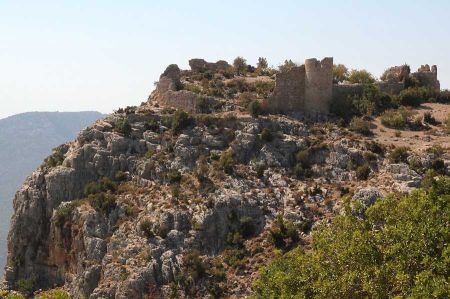The ruins of Tokmar Kalesi near Silifke
- Written by Portal Editor
After visiting Yilan Kalesi near Ceyhan and the Lambron Castle near Camliyaila, we drove back to Tarsus and then took the coastal road D 400 in the direction of Silifke via Anamur and Gazipasa to Alanya.
A winding road, which stretches along the coast, but with sensational views onto the sea and some ancient sites along the way. Driving on this stretch of land is time-consuming and partly dangerous due to the confusing curves, but the greater amount of time is always worth it. Wonderful coastal landscape with secluded bays that invite you to swim or linger, cliffs and rocks that make the sea roar. On the way you will already come across the expressway that is under construction, which will connect Alanya and Silifke or Adana with each other in the future.
Remains of the ruins of Tokmar Kalesi await us
Behind Silifke we drove through the ferry port Taşucu, which will certainly not be unknown due to many travelers to Cyprus, as the only car ferry along the Reviera to Cyprus leaves from here, to follow a road that turns right about 25 kilometers later, which serpentines lead up to the mountain to Tokmar Kalesi. The medieval castle ruins, also known as Castellum Novum, were the goal of our planned stopover on the way to Alanya. After about 5 kilometers you can already see the Tokmar Kalesi castle ruins on the left, which are located at an altitude of 400 meters above sea level. A drivable path leads to the ruin, but we parked our vehicle directly at the driveway to the castle and walked about 150 meters to the ruin. Already during the walk along the Kale Tepesi, as the locals aptly call the castle mountain, which connects to a ridge of the Akçalı Dağları, the view of the coast and the shallow bay of Barbaros Köyü opens up to us.
Here, too, there is another name for the place among the local population with Tahta Limani, which is perhaps related to the ancient port of Palaiai, which is about 4 kilometers to the east. In the map of Asia Minor by historian Richard Kiepert, Tokmar Kalesi is entered as Palaea Castle, which suggests that the castle was once built to protect the port or at least had to fulfill this as a secondary task. In the records of Portolan Rizo from 1490, Tokmar Kalesi is mentioned as a landmark, but here under the name "Lo Chastel Chamandrachi". Since there have been no investigations in the fortress known to us so far, the information about the castle available from the local population should be treated with caution.
Similar construction to the construction of Yilan Kalesi
If you take a closer look at the fortress from an architectural point of view, it is easy to see construction features and properties in the building from the 12th century. There is also a certain comparability with Yilan Kalesi, which is why this fortress is often assigned to the group of small Armenian fortresses. The polygonal fortress walls of Tokmar Kalesi, which enclose a base area of 50 by 70 meters, follow the given terrain as is usual with other fortresses on mountain spurs. On the north side of the fortress, the four semicircular bastions that were once used for defense are still quite well preserved, even if most of the curtains in between have collapsed. The firing slots on the upper floors of the bastions are still clearly visible.
As in other fortresses, the building materials from the collapsed parts were often used for other structures. You can find ashlar stones of the castle in the neighboring village Akdere in the built-up state. The curtains once had a wall thickness of around 1.50 meters, the masonry itself was built in double-shell construction from bosses ashlars. This type of construction made of limestone was also used for the bastions. Battlements and parapets have crashed over the centuries, and the walkways can only be guessed at.
Of the former Zwinger on the east side of the castle, only the foundations of the outer walls can be seen, the main gate front and the gate itself have also disappeared. In the southeast of the fortress there are still remnants of a residential building that can still be assigned, all other buildings can only be seen as piles of rubble.
Other historians' records suggest a certain identity with Norpert Castle, which was mentioned in 1199 and 1210 as the property of Sevasdios Heri. The Armenian King Leon II is said to have handed over the fortress, which was then also called Castellum Novum, together with the city and the citadel of Silifke, to the Johanniter in 1210. In return, Leon II received armed support from 400 knights and their entourage in the fight against the Seljuks as well as an annual payment of an unknown amount. The Silifke Kalesi was returned to the Armenians in 1226. No further records are known about the further course of the Tokmar Kalesi. It is likely that Tokmar Kalesi must have been an aristocratic castle that was built to rule the area west of Seleukia on the Kalykadnos (Silifke) to the Gulf of Ovacık, today's Yeşilovacık. In the series of small Armenian fortresses, Tokmar Kalesi was the most westerly element.
Geographical location 36 ° 15 ′ 23 ″ N, 33 ° 46 ′ 14 ″ E
Please also read:
Herakleia Lynkestis - a day tour to Bitola
Poznan / Poznan - another tour of the city
